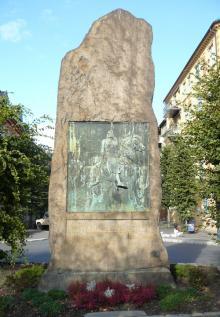An estimated 25 ancient Norwegian kings are buried in unmarked graves round the country. An archaeologist and king expert thinks the most notable of these should be exhumed.
Juliet Landrö / Hilde Zahl
Source - http://sciencenordic.com/norway-should-also-dig-its-%E2%80%9Ccar-park-kings%E2%80%9D

According to the Icelandic poet and historian Snorri Sturluson, Oslo was founded by Harald Hardrade, best known abroad for his failed attempt at conquering England in 1066. (Illustration: Snorre Sturluson: Heimskringla, J.M. Stenersen & Co, 1899)
The recent discovery of the legendary King Richard III’s grave beneath a car park in Leicester made the news worldwide.
Archaeologist Øystein Ekroll hopes some of this momentum will carry across to Norway and lead to searches for the remains of medieval kings of Norway.
He thinks the first of them should be Harald Hardrade, who lies buried beneath the sewer system under a street in Trondheim.
“He is the king who is most renowned outside Norway, along with St. Olaf,” says Ekroll.
Hardrade [meaning Hard Rule] was a half-brother of King Olav II, who was canonized as St. Olaf. Hardrade was wounded at the battle of Stiklestad but escaped through Sweden and Russia and spent 15 years soldiering in the service of the emperor in Constantinople, the city known to the Vikings as Miklagard.
He died at Stamford Bridge in 1066 trying to conquer England, and the year is generally considered to mark the end of the Viking Era. A year later Hardrade’s bones were sent back to Norway. The corpse of a person of his rank could have been salted and dried or alternatively boiled to remove all tissue.
Ekroll thinks there is a good chance that the corpse is well preserved and perhaps his DNA could be linked to known descendants or the remains of other dead kings.
Maybe such an excavation would reveal what he looked like – he was said to be six feet tall.
“It would be fascinating to find out how he was slain, if anything can be said about his age, height and possible diseases. Perhaps relics could be found in his grave,” says Ekroll.
Blank spot in history
A proposal was made in 2006 to excavate the skeletal remains of Harald Hardrade and move them to the nearby Nidaros Cathedral. The Directorate for Cultural Heritage did not support the idea.
Nor does Ian Reed of the Norwegian Institute for Cultural Heritage Research.
He thinks it would be most difficult to ascertain whether any skeletal remains actually had belonged to a king.

A monument of the Saga King is centred in Harald Hardråde’s Circle in Oslo. But no such monument is found in Trondheim at his burial site. (Photo: Chell Hill)
“Archaeology is an area where we have to be meticulous with our source material. We cannot excavate just because we are dealing with a royal grave,” says Reed.
Ekroll, however, fears that the remains of Norwegian kings can disappear if we wait too long to dig them up.
He asserts we are maintaining holes in Norwegian history by not finding out everything possible about ancient kings and queens.
“When we travel abroad and visit various attractions these often include graves of historical kings and queens in great cathedrals. We’ve had a similar history but there are many rulers we forget.”
In the UK all the remains of kings since the year 1000 have been found and now the search is on for King Alfred the Great from the 800s.
Most are located
In the Middle Ages it was only common for kings and bishops to be buried indoors. We know of the Norwegian kings who were buried in Nidaros Cathedral in Trondheim from 1000 to 1200 AD. From 1200 to 1300 AD they were buried in what was Bergen Cathedral and after Oslo became the capital of Norway kings were buried there, explains Ekroll.
The old graves in Nidaros Cathedral are marked by nine crosses in the stone floor in front of the large alter.
“We can assume that four or five of these graves are for kings,” says Ekroll.
The old cathedral in Bergen was blown up in the during construction of a fortress on the same site, so there is little hope of finding any old royal graves there now.
By chance, the remains of Haakon V Magnusson were found during an excavation of the ruins of the St. Mary’s Church in the old part of Oslo in the 1860s. He died in 1319 and is the only Norwegian medieval king whose grave has been excavated.
Translated by Glenn Ostling